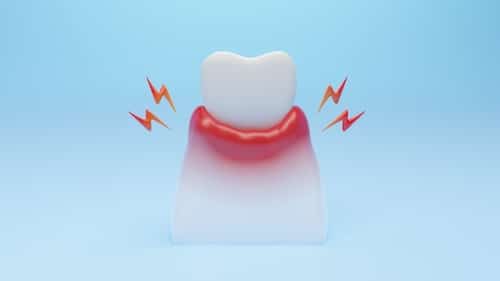Gum disease is an infection of the tissues that surround and support your teeth. It is a major cause of tooth loss in adults. Because gum disease is normally painless, you may not know you have it. Also referred to as periodontal disease, gum disease is caused by plaque, the sticky film of bacteria that is constantly forming on our teeth.
The sooner you treat gum disease the better. The early stage of gum disease is called gingivitis. If you have gingivitis, your gums may become red, swollen and bleed easily. At this stage, the disease is still reversible and can usually be eliminated by a professional cleaning at your dental office, followed by daily brushing and flossing.
Advanced gum disease is called periodontitis. Chronic periodontitis affects nearly half of adults over 30 years old in the United States. It can lead to the loss of tissue and bone that support the teeth and it may become more severe over time. If it does, your teeth will feel loose and start moving around in your mouth. This is the most common form of periodontitis in adults but can occur at any age. It usually gets worse slowly, but there can be periods of rapid progression.
4 Signs of Gum Disease:
Your smile may look healthy, but something quite unhealthy may be going on without notice. Gum disease can be aggressively spreading without you even realizing it. Gum disease damages tissue and bone which can lease to tooth loss is caused by a buildup of plaque due to poor oral hygiene. The following are signs to help you pick up signs of gum disease even during early stages:
- Bleeding: unless you are brushing or flossing too hard, normally your gums won’t bleed. If they do bleed with light to moderate pressure, this may be a sign that the gum tissue is inflamed and weak due to infection.
- Inflammation and redness: If you notice that your gums are swollen or reddened, it could be from inflammation. Inflammation is the body’s way of responding to fight an infection, but over a long period of time, the body begins to damage the tissue instead of protecting it.
- Abscesses: these are areas in the gums where the infection has become isolated. They usually are swollen more than the surrounding gum tissue because they are filled with pus. They are sensitive to the touch, and should be examined by your dentist if the symptoms occur for more than a few days.
- Loose or moving teeth: Teeth that have shifted their position or become loose in the gums are signs of advancing gum disease. This occurs because the gum and bone that hold the teeth are weak and losing the attachment. Immediate treatment from your dentist is advised as to not lose the teeth all together.
If you notice any of these signs/symptoms, you should see a professional as soon as possible for an exam. The sooner your dentist can diagnose and begin treatment of gum disease, the less harm and permanent damage will be done to your teeth and gums.

